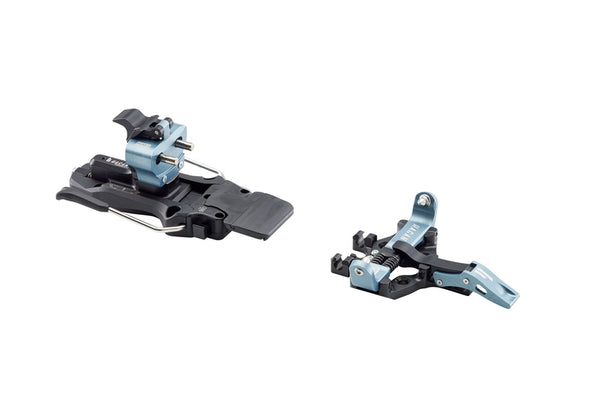HAGAN Boost 12 vs Core 12 Pro vs Pure 8/10 bindings
by Michael Hagen January 13, 2022 5 min read
Trying to decide between the Boost 12, Core 12 Pro and Pure 8/10 and not sure of the differences?
Here's a little help.
Let's start with the Boost 12 versus the Core 12 Pro.
The heels are identical except - very big except - the Boost 12 brakes aren't on the heels. They are on the toes!
Toe-mounted ski brakes are unusual.
They look a little strange. Weird even. Heel-mounted brakes being the standard, you know. So why depart from standard? Wouldn't you rather just go with the flow and blend in with the crowd. You wouldn't want to be unusual and stick out, would you? That would take a bit of open-mindedness and courage. Who has that? Even if there are advantages, big advantages, to going your own way.
Here are four reasons Hagan Boost 12 bindings have front mounted brakes - and the big advantages of the Boost 12 brake system. Astute ski tourers will figure it out. You don't need to let the oblivious in on the secret:

- The HAGAN Boost 12 brakes are always active (in both descend AND climb modes.) Always Active means if the toe of your boot isn't in the toe piece, the brake WILL be deployed. They can't be locked away if the boot isn't in the toe piece. This means you also can't FORGET to release your brake - and realize it when you see your ski heading down a couloir.
- The brake retraction is done with the same lever, and same motion, as locking the toe for uphill climbing mode. It saves steps, and time, over separately retracting the brake at the heel, then locking the toe piece. The locking and retracting motion is smooth and easy.
- Toe-mounted brakes don’t interfere with heel release. No worries about friction with the brake pad interfering with smooth and reliable heel release. (The front brakes don't interfere with toe release, either, for that matter.)
- The Boost 12 bindings are light, because the heel tower doesn't have to beefed up to perform the additional duty of holding the brakes in a retracted position - with an awkward twisting to hold down the brake. The brakes also don’t need to be beefed up to withstand repetitive “stomping” during heel click in.
- The Boost 12 bindings are about 47 grams heavier than the Core 12 Pro. But the convenience of retracting the brakes with a single movement of the toe lever, combined with eliminating the possibility of forgetting to release the brakes for the descent may be worth it. Weigh in your mind 47 grams versus loosing a $1000+ ski/binding and walking out!
There are also differences in the toe pieces. Most of those differences (other than the brakes, obviously) are the same as those between the Pure 8/10 and the Core 12 Pro.
So let's move on to the differences between the Core 12 Pro and the Pure 8/10:

There are differences in both the heel and toe.
Heel: There are two risers (for five climbing heights) on the Core 12 Pro and Boost 12 versus one riser (for three positions) on the Pure 10. The Core 12 Pro/Boost 12 risers are magnetic – a little easier to flip. The Core 12 Pro/Boost 12 have 25 mm length adjustment where the Pure 8/10 has 20 mm. And of course the Core 12 Pro/Boost 12 have a higher Z-value (DIN) range of 5-12 versus the 5-10 of the Pure 10 (or 3-8 of the Pure 8). All have the Elastic Response System.
If you think you may want to set the release below a DIN 5, then consider the Pure 8. The Pure 8 is identical to the Pure 10 but with a 3-8 DIN range.
Freeride spacers are only compatible with the Core 12 Pro and Boost 12 and increase downhill performance to near alpine binding levels, at a fraction of the weight of hybrid bindings like the Shift.
Toe: The Core 12 Pro toe piece has a wider mounting plate, snow-block anti-icing system and uphill retention adjustment.The Pure 8/10 is about 50 grams lighter than the Core 12 Pro.
You have to decide whether the extra climbing heights, increased adjustment range and toe features are worth the extra weight. Personally, I prefer the Pure 8/10 despite those features of the Core 12 Pro. If you aren’t a weight weenie like me, you may prefer the Core 12 Pro.

PURE 10 FEATURES
WEIGHT: 280 grams.REVOLUTIONARY SKI-BRAKE: incredibly light and easy to operate; two positions (retracted for uphill and released for downhill) via pushing a catch lever. See the short videos for brake operation.
ELASTIC RESPONSE SYSTEM: an elastic sliding system in the heel allows unrestrained flex of the ski during compression and excellent skiing performance.
SKI BRAKE ELASTIC SLIDE: integrated in the ski-brake pad to keep the lateral release value of the binding fixed.
SKI BRAKE: included, with sizes 75, 86, 91, 97, 102, 108 and 120 mm to provide the perfect fit with any ski model.
HEEL FLAP WITH RISER: intuitive heel flap system provides 3 different walking modes: FLAT MODE, + 36 mm and +50 mm.
CAM HEEL RELEASE SYSTEM® (Adjustable Release 3-8): a cam system which drives the Vertical release (My) of the binding in case of a fall. The cam system is extremely precise and reliable, and at the same time very light and small.
ROTATIONAL SYSTEM (Adjustable Release 3-8): this patented system provides the side release (Mz) adjustment.
20 mm ADJUSTMENT PLATE: integrated in the heel part enables fast adjustment in case of boot substitution (up to 2 full sizes).
INTEGRATED CRAMPON HOOKS ®: the included and removable crampon hooks integrate into the base of the toe piece for extreme rigidity and lightness!!
MATERIALS: Aluminum alloy, Injection-molded POM thermo-plastic, Stainless steel
PURE 10 AND CORE 12 PRO DIFFERENCES
TOE PIECES: The Core 12 Pro toe piece has a wider mounting plate, snow-block anti-icing system and uphill retention adjustment.
RISERS: Two magnetic flaps on the Core 12 provide 5 climbing positions, a single flap on the Pure 10 provides 3.
LENGTH ADJUSTMENT: 20mm for the Pure 10, 25mm for the Core.
RELEASE RANGE: Pure 10 is DIN 5-10, Core 12 is DIN 5-12.
I don’t think one is necessarily better than the other. If you want the lightest weight, the Pure 10 is fantastic. If you want a few more features and climbing heights and don’t mind the extra weight, the Core 12 Pro is great. If you want the always active brakes so you don't need to worry about losing a ski, get the Boost 12.
One Last Thing:
Hagan bindings are made by ATK in Italy. Up until recently, we were the only brand to import ATK bindings into the U.S. Now Black Diamond distributes ATK bindings in the U.S.
You could buy from Black Diamond or one of the many Black Diamond retailers. (Many more than Hagan.)
Why purchase a Hagan version of an ATK binding instead?
- Support a small business. Hagan USA is a family-run business as is Hagan Austria. Black Diamond is BIG. I wouldn't be surprised if they sell more in an afternoon than we do in a year.
- Better service. Being small means we provide more personal, responsive service. No bureaucratic hoops to jump through. No struggles just trying to get through a phone system to find someone that will speak to you. The cell phone number at the bottom of our website is my personal cell phone number.
- Better expertise. We know the bindings very well. We ski them - a lot. Black Diamond reps sell the entire, huge, BD product line. You are lucky if they even ski, much less have any expertise in alpine touring bindings.
- Price. BD is a big corporation with big corporation expenses and mandated minimum profit margins. This means they charge retailers more for ATK bindings than we charge them for the identical Hagan bindings. And that means retailers have to charge you more for ATK bindings than Hagan bindings.
We appreciate your supporting Hagan and pledge to provide exceptional service and customer care.
Leave a comment
Comments will be approved before showing up.
